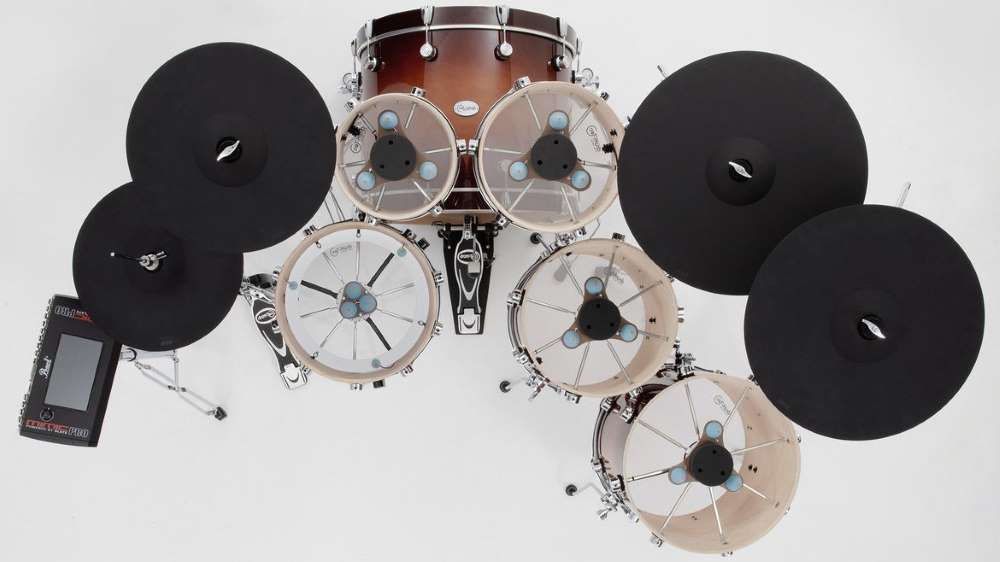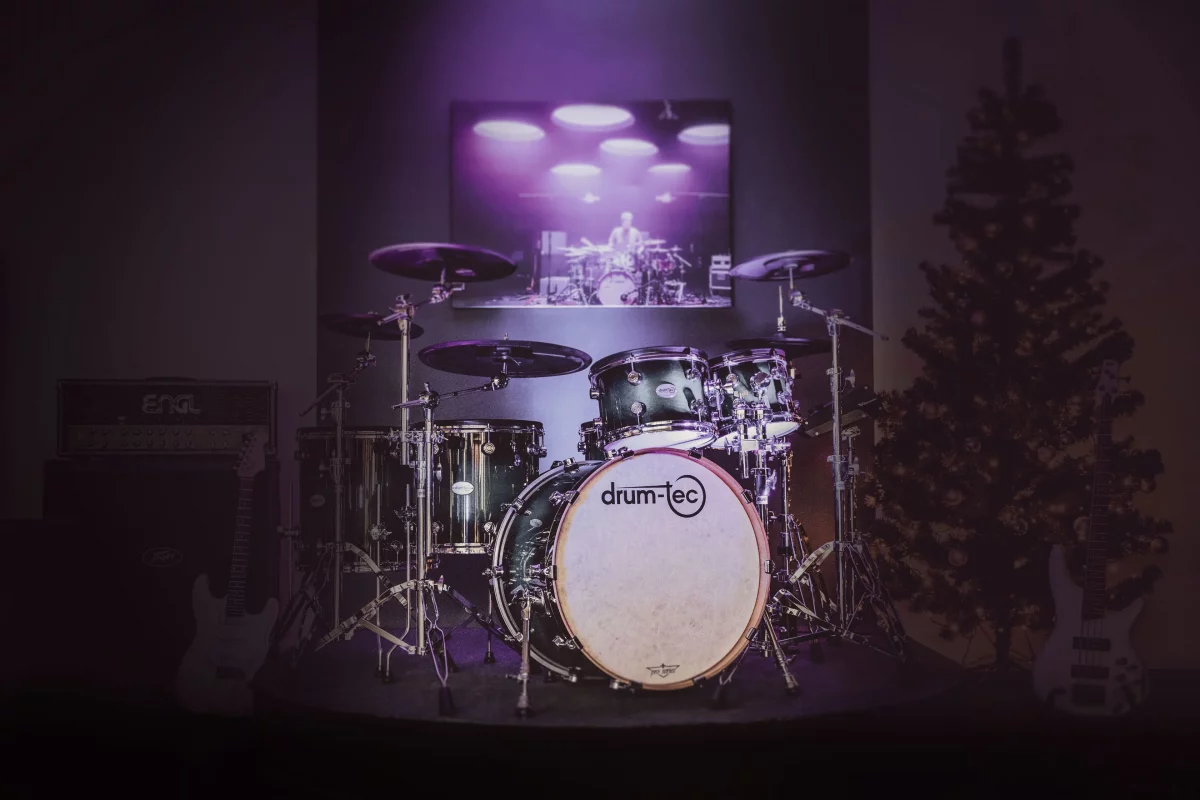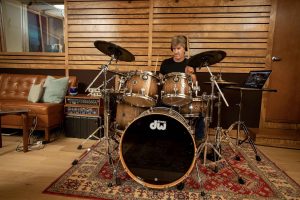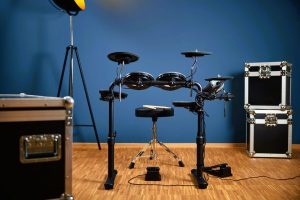A new high-end electronic drum kit has just entered the market from one of Europe’s largest drum builder and retailer – the Drum-Tec Pro 3 – which rivals the Roland VAD 706 at the top end of the eDrum market. Below, we take a look at the new Drum-Tec kit, compare it to the competition, and offer our first impressions on whether this is a kit worth considering.
Who is Drum-Tec?
Drum-Tec might not be a well-known global name in eDrums, but the company has actually been around since 2004, founded by Konrad Mueller-Bremeyer in Germany. While browsing eBay for electronic drum parts for his Simmons kit, Konrad came across now-defunct eDrum company Hart Dynamics and realised there was a gap in the market in Europe for an eDrum specialist.
Starting out as a distribution company working with the likes of Roland, Yamaha and DDrum, Konrad eventually grew the business to begin making its own eDrum range with a difference – they looked just like acoustic drums. In fact, the company’s Jam, Diabolo and Pro series drums actually pre-date the introduction of other acoustic-style eDrums like the ATV aDrums or Roland VAD series.
The company own two showrooms in Germany, and still sells other brands of eDrums alongside their own, making Drum-Tec one of the few eDrum specialists where you can compare a wide range of brands side-by-side.
The Pro 3 is the latest addition to the Drum-Tec range and the new flagship in the range, which we review here.
Related: Compare the best Roland eDrum kits
What’s new with the Drum-Tec Pro 3 Kit?
The Pro 3 is the latest version of the Pro kit, Drum-Tec’s flagship range. The new kit introduces an exciting new feature – a hotspot-less, multi-sensor trigger system, while still supporting positional sensing on the Roland TD-27, TD-50X, and Pearl Mimic Pro modules.
This trigger setup is one of the more complex I’ve seen. Historically, eDrums would only have a single sensor, which would be mounted either in the middle of the drum head to provide positional sensing support, or near the edge of the head. More expensive eDrums like those found on higher-end Roland kits would use centre-mounted sensors. However, the key downside of this is hot-spotting, which is when striking the drum directly on the trigger cone would max out the signal to the module, causing inaccurate triggering.
Drum-Tec’s new multi-sensor trigger system
Drum-Tec claims to have resolved this with a complex 7 and 3-trigger array on their Pro 3 snare and tom pads.
The snare uses a whopping 7 sensors – three arranged in a triangle in the middle and a further three around the edge of the drum head. The final one is not visible in the photography but is set to pick up the rim input.

Positional sensing works on this drum by using the outer and inner rings of sensors in tandem to identify the position of where the drum is played. Drum-Tec even claims that this works independently of the head tension, meaning you’re free to choose a tension that suits your preferred rebound feel.
The snare is topped off with an external switch to set the correct input level, allowing for compatibility with a wide range of drum modules.
Meanwhile, toms are equipped with three head sensors surrounding a dampening cushion that takes up around one-third to one-half the circumference of the drum. Again, these triggers provide position detection regardless of the head tension. Toms are wrapped up with a rim sensor.

Unlike Roland’s KDA-22 bass drum sensor, Drum-Tec uses a full-sized mesh head with what looks like a giant dampening pad across almost the entire head. This leaves a relatively small area free around where the pedal makes contact, allowing drummers to bury the beater. Of course, double pedals are compatible, with the single sensor located precisely between where the pedals would make contact.

All drums are topped off with Drum-Tec Real Feel drum heads, a triple-ply design that I’ve been using on my own kit for a few years now. The thickness means they are as close as you can get to the feel of real acoustic drums, with a bit less rebound than twin-ply heads.
Video Demo
What eDrum modules work with the Drum-Tec Pro 3?
Drum-Tec does not actually offer an own-brand drum module. Instead, the Pro 3 can be purchased in a set with one of several choices of drum modules from other manufacturers. The Pro 3 works with any drum module that uses the Roland system of drum triggers. This means Yamaha modules will not work correctly with this eDrum kit, but you can choose from a wide range of other modules.
Configurations are currently available with four different modules:
- Roland TD-27
- Roland TD-50X
- Pearl Mimic Pro
- Gewa G9
Purchasing the kit with one of the two Roland modules will swap out the Drum-Tec snare for a Roland Digital Snare, meaning you’ll have the full set of three digital drum pads.
If you pick a kit with a module, you’ll also get a set of cymbals bundled to match that module. For example, a Roland module will net you a set of matching Roland cymbals, whereas opting for a Gewa G9 will mean a bundled set of Gewa cymbals. Only the Pearl Mimic Pro package offers a mix of brands, where you’ll receive a set of ATV cymbals, as there is no matching range of pads for the Mimic Pro from Pearl.
As an extra bonus, drum modules sold by Drum-Tec even come with a set of exclusive drum presets loaded onto the modules – known as their “live sound edition”.
It is also possible to buy a Pro 3 kit without a module, giving you an upgrade path if you have an older drum kit. You could also buy your own module separately from the likes of ATV or 2Box, if you’d prefer.
What configurations are available?
In total, the following drums are available in the range:
- 14×5.5 or 14×7 Snare
- 20×16 or 22×16 Kick drum
- 8×7 Tom
- 10×7.5 Tom
- 12×8 Tom
- 14×13 Tom
- 16×15 Tom
Currently, there are 16 different configurations available in each of the four finishes. These include 1 up 1 down, 1 up 2 down, 2 up 1 down, or 2 up 2 down, plus different options for the two sizes of snare and bass drum.
Four different finishes are available, including piano black, piano white brown sunburst and blue burst. Personally, I would pick either of the burst finishes, as they help to visually differentiate the kit from the all-black Roland VAD 504 and 507 series. A further 3 finishes are due to be released soon, so it may be worth holding on if none of these takes your fancy.
What are Drum-Tec drum shells made from?
Drum-Tec drum shells are supplied by Sonor, a leading brand of acoustic drums also based in Germany. The shells are 6-ply birch, meaning they are likely to sound excellent as acoustic drums as well if you were to take out the electronic components.
Drum-Tec partners with Drum Center of Portsmouth
Following the Pro 3 launch, Drum-tec announced a partnership with Drum Center of Portsmouth as the brand’s exclusive US distributor.
At the time of writing, Drum-Tec products are not available on the Drum Center of Portsmouth’s website, however, when they go live, this might make Drum-Tec products more affordable and easier to buy in the USA. Previously, customers would have shipping calculated by weight and cover customs charges.
FAQs
Verdict: Who should consider a Drum-Tec Pro 3 electronic kit?
The Drum-Tec Pro 3 certainly doesn’t come cheap, costing around 14% more than an equivalent spec Roland 706 with the same TD-50X module. However, unlike the Roland flagship, the Pro 3 can be paired with other modules such as the cheaper TD-27, or even purchased without a module at all. This flexibility will be welcome by eDrum owners who have a perfectly good older module such as a TD-30 and are frustrated that Roland will not sell an upgrade set of VAD shells.
The Pro 3 is clearly a very high-end range of eDrums, and is worth considering if you are in the market for a high-end kit. While being a less-known brand, the company backs up its workmanship with a 5-year warranty, which is better than the 2 years Roland offers on the V-drum range. And despite being a third-party kit, a full set of trigger settings is provided, so the experience is likely to be not far off buying an official Roland product.
All in all, the Pro 3 may be a good option for drummers with a large budget who want something slightly different from the mainstream. Despite the Roland VAD 706’s eye-watering price tag, it is still only available in one configuration. Meanwhile, the Pro 3 can be completely customised to your requirements, with a myriad of different configurations. Similarly, the drums look visually different to Roland’s range, particularly in the burst finishes.
The result is a completely bespoke kit that you might only otherwise get by building your own acoustic-to-electronic drum conversion – but backed by a warranty.
For more information on the Drum-tec Pro 3, visit the dedicated site at drum-tec-series.de/pro/, or browse the range at the Drum-Tec website.
Photography copyright: Drum-Tec




